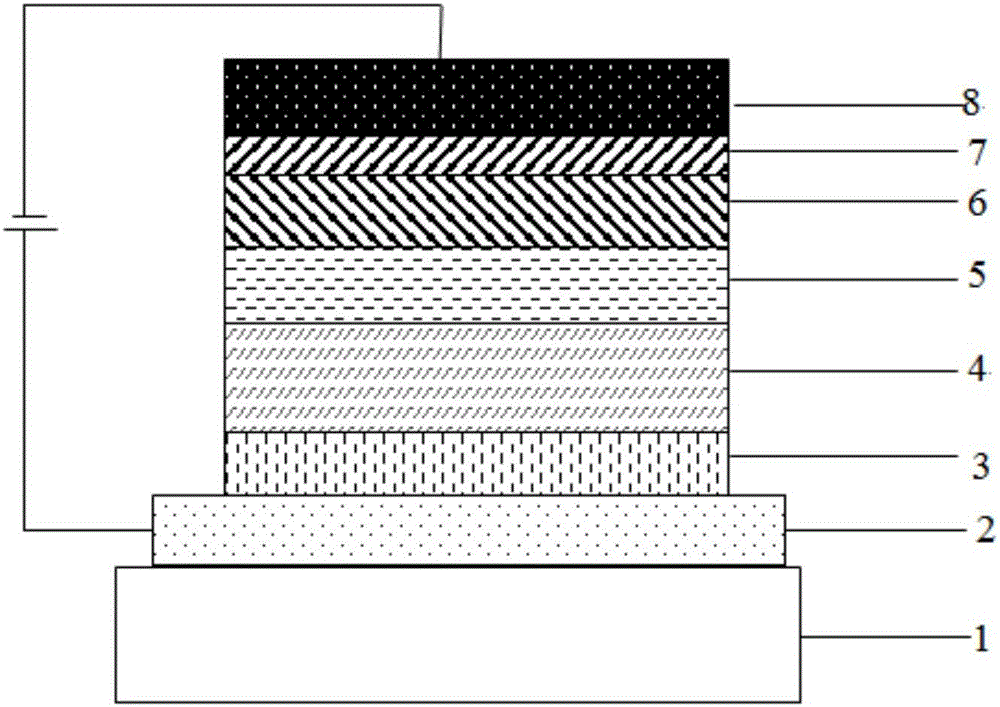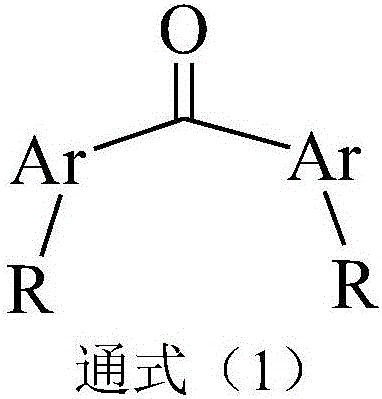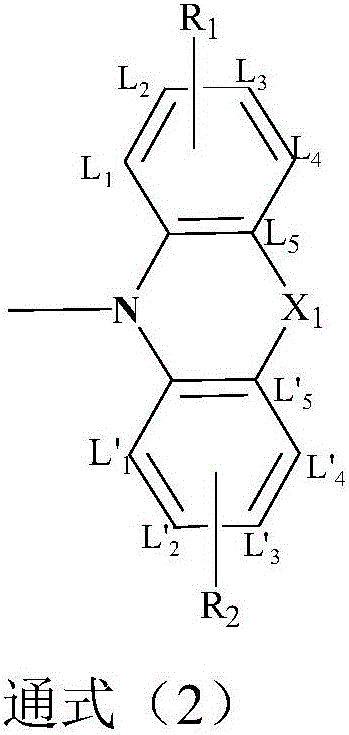Compound based on diaryl ketone and application of compound to organic electroluminescence device
A technology of diaryl ketones and compounds, applied in electric solid devices, electrical components, luminescent materials, etc., can solve the problems of low S1 state radiation transition rate, efficiency roll-off, difficult exciton utilization and high fluorescence radiation efficiency. , to achieve good industrialization prospects, increased orbital overlap, and good fluorescence quantum efficiency.
- Summary
- Abstract
- Description
- Claims
- Application Information
AI Technical Summary
Problems solved by technology
Method used
Image
Examples
Embodiment 1
[0044] Example 1 Compound 1
[0045] The concrete synthetic route of this compound is provided now:
[0046]
[0047]In a 250ml four-necked flask, add 0.01mol 4,4'-dibromobenzophenone, 0.025mol 6,6-dimethyl-6,11-dihydro-13-oxa -11-aza-indole[1,2-b]anthracene, 0.03mol sodium tert-butoxide, 1×10 -4 mol Pd 2 (dba) 3 , 1×10 -4 mol of tri-tert-butylphosphine, 150ml of toluene, heated to reflux for 24 hours, sampling plate, the reaction was complete; naturally cooled, filtered, the filtrate was rotary evaporated, and passed through a silica gel column to obtain the target product with a purity of 99.2% and a yield of 67.00%.
[0048] Elemental analysis structure (molecular formula C 55 h 40 N 2 o 3 ): theoretical value C, 85.03; H, 5.19; N, 3.61; O, 6.18; test value: C, 84.99; H, 5.21; N, 3.70;
[0049] HPLC-MS: The molecular weight of the material is 776.30, and the measured molecular weight is 776.83.
Embodiment 2
[0050] Example 2 Compound 6
[0051] The concrete synthetic route of this compound is provided now:
[0052]
[0053] In a 250ml four-necked flask, add 0.01mol 4,4'-dibromobenzophenone, 0.025mol 11,11-dimethyl-4a,6,11,13a-tetrahydro- 13-thia-6-aza-indo[1,2-b]anthracene, 0.03mol sodium tert-butoxide, 1×10 -4 mol Pd 2 (dba) 3 , 1×10 -4 mol of tri-tert-butylphosphine, 150ml of toluene, heated to reflux for 24 hours, sampling plate, the reaction was complete; naturally cooled, filtered, the filtrate was rotary evaporated, and passed through a silica gel column to obtain the target product with a purity of 99.0% and a yield of 69.00%.
[0054] Elemental analysis structure (molecular formula C 55 h 42 N 2 OS 2 ): theoretical value C, 81.45; H, 5.22; N, 3.45; O, 1.97; test value: C, 81.50; H, 5.21; N, 3.40;
[0055] HPLC-MS: The molecular weight of the material is 810.27, and the measured molecular weight is 810.65.
Embodiment 3
[0056] Example 3 Compound 11
[0057] The concrete synthetic route of this compound is provided now:
[0058]
[0059] In a 250ml four-necked flask, add 0.01mol 2,2'-dibromobenzophenone, 0.025mol 6,6-dimethyl-13-phenyl-11,13-dihydro -6H-11,13-diaza-indole[1,2-b]anthracene, 0.03mol sodium tert-butoxide, 1×10 -4 mol Pd 2 (dba) 3 , 1×10 -4 mol of tri-tert-butylphosphine, 150ml of toluene, heated to reflux for 24 hours, sampled and plated, the reaction was complete; naturally cooled, filtered, the filtrate was rotary evaporated, and passed through a silica gel column to obtain the target product with a purity of 99.5% and a yield of 72.00%.
[0060] Elemental analysis structure (molecular formula C 66 h 49 N 4 O): theoretical value C, 86.80; H, 5.44; N, 6.04; O, 1.73; tested value: C, 86.63; H, 5.29; N, 6.30;
[0061] HPLC-MS: The molecular weight of the material is 926.40, and the measured molecular weight is 926.52.
PUM
| Property | Measurement | Unit |
|---|---|---|
| current efficiency | aaaaa | aaaaa |
Abstract
Description
Claims
Application Information
 Login to View More
Login to View More - R&D
- Intellectual Property
- Life Sciences
- Materials
- Tech Scout
- Unparalleled Data Quality
- Higher Quality Content
- 60% Fewer Hallucinations
Browse by: Latest US Patents, China's latest patents, Technical Efficacy Thesaurus, Application Domain, Technology Topic, Popular Technical Reports.
© 2025 PatSnap. All rights reserved.Legal|Privacy policy|Modern Slavery Act Transparency Statement|Sitemap|About US| Contact US: help@patsnap.com



